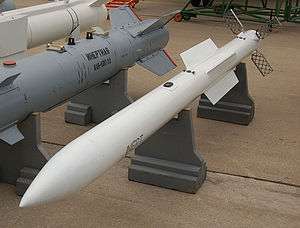Grid fin




Grid fins (or lattice fins) are a type of flight control surface used on rockets and bombs, sometimes in place of more conventional control surfaces, such as planar fins. They have been used since the 1970s in various Soviet ballistic missile designs such as the SS-12 Scaleboard, SS-20 Saber, SS-21 Scarab, SS-23 Spider, and SS-25 Sickle, as well as the N-1 (the intended rocket for the Soviet moon program).
In Russia, they are often referred to as Belotserkovskiy grid fins[1] after Russian computational mechanician Sergey Belotserkovskiy (also known as an advisor of Yuri Gagarin aerospace engineering thesis, where grid fins were examined too[2]), who developed them in 1950s.
Grid fins have been used on conventional missiles and bombs such as the Vympel R-77 air-to-air missile; the 3M-54 Klub (SS-N-27 Sizzler) family of cruise missiles; and the American Massive Ordnance Air Blast (MOAB) large-yield conventional bomb. They have also been used on specialized devices such as the Quick-MEDS delivery system and as part of the launch escape system for the Soyuz spacecraft.
In 2014, SpaceX tested grid fins on a first-stage demonstration test vehicle of its reusable Falcon 9 rocket,[3]and on December 21, 2015 they were used to guide a commercial Falcon 9 first stage back to land for the first successful booster stage landing in spaceflight history.
Design characteristics
Conventional planar control fins are shaped like miniature wings. By contrast, grid fins are a lattice of smaller aerodynamic surfaces arranged within a box. Their appearance has sometimes led them to be compared to potato mashers or waffle irons.
Grid fins can be folded, pitched forward (or backwards), against the cylindrical body of a missile more directly and compactly than planar fins, allowing for more compact storage of the weapon; this is of importance where weapons are launched from a tube or for craft which store weapons in internal bays, such as stealth aircraft. Generally, the grid fins pitch forward/backward away from the body shortly after the missile has cleared the firing craft. In the case of the MOAB, grid fins allow the weapon to fit inside a C-130 cargo bay for deployment while the craft is in flight.
Grid fins have a much shorter chord (the distance between leading and trailing edge of the surface) than planar fins, as they are effectively a group of short fins mounted parallel to one another. Their reduced chord reduces the amount of torque exerted on the steering mechanism by high-speed airflow, allowing for the use of smaller fin actuators, and a smaller tail assembly overall.
Grid fins perform very well at subsonic and supersonic speeds, but poorly at transonic speeds; the flow causes a normal shockwave to form within the lattice, causing much of the airflow to pass completely around the fin instead of through it and generating significant wave drag. At high Mach numbers, grid fins flow fully supersonic and can provide lower drag and greater maneuverability than planar fins.
.jpg)
Application in reusable launch vehicles
.png)
SpaceX Falcon 9-R[4] — Grid fins are being used for increased precision in control of the landing location for reusable launch vehicles. A development program is currently underway, and the first flight test with grid fins was in February 2015.
References
- ↑ Zaloga, Steve (2000). The Scud and Other Russian Ballistic Missile Vehicles. New Territories, Hong Kong: Concord Publications Co. ISBN 962-361-675-9.
- ↑ http://www.nkj.ru/archive/articles/10523 (Russian)
- ↑ SpaceX (2014). "F9R 1000m Fin Flight | Onboard Cam and Wide Shot". https://www.youtube.com/watch?v=DgLBIdVg3EM. External link in
|website=(help); - ↑ http://www.spaceflight101.com/spacex---f9r-development-updates.html
External links
- Missile Grid Fins, Aerospaceweb.org
- Conventional Weapons Technology Group, Defense Technical Information Center
- "It's the Big One", Aviation Week
- KLUB (SS-N-27) ASCM, Bharat-Rakshak.com
- Small Smart Bomb with Range Extension, Air Force Research Laboratory
- Medical Missile Prepped for Launch, DefenseTech.org